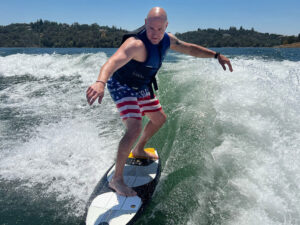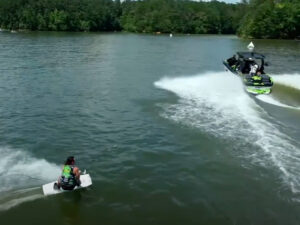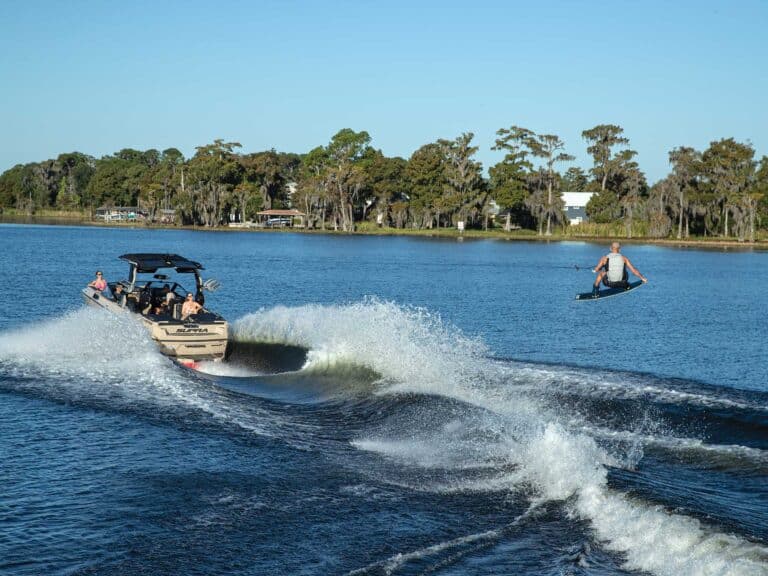
The Interview: Chris Anthony, Epic Boats founder and CEO
Interview: Luke Woodling; Photos: Frankie Guerrero
In February, Epic Boats made gas-free sessions a reality with the release of the 23e, the world’s first hybrid electric wake boat. We interviewed Epic founder and CEO Chris Anthony for a feature in our June issue. Be sure to check out a video of the boat in action and a gallery of pics here.
WBM: From my understanding, this is an electric boat that is recharged with a combustion engine. How exactly does that work? Chris Anthony: The 23e is a series hybrid. Series hybrid technology is nothing new — it’s been around since the ’40s and ’50s, and locomotives and submarines use it. It’s basically an electric propulsion system operated with a generator that charges the batteries. So the engine that drives and propels the boat is all electric. In addition to all that, you have a generator that continues to run as it recharges your batteries. Therefore, you get more use and longevity out of your charge time. And it’s a plug-in hybrid, so when you get back to your dock house, you can plug it into any 110 or 220 outlet. The dream scenario is that you have a dock house with a 220 plug and at least five kilowatts of solar energy coming from the top of your roof so you can completely run the boat off of solar energy. That way you’re only using renewable resources to fuel your recreation.
So say I’m going out for a morning session, and I’d charged the boat at my dock house through solar power. How long would that charge last? The studies we conducted show if you were to go out with some advanced riders, and you were doing some heavy wakeboarding — meaning when one riders gets out of the water another rider jumps in — you can wakeboard for about an hour on electric only. But the average wakeboarder will be able to stay out longer because he’s turning around to pick up riders more often, which requires less energy. If you’re wakeboarding like that or wakesurfing, you’ll likely get up to four hours on one charge.
Why is that? The more you’re going full speed, the more you’re depleting the battery life. If you’re stopping and turning around, you won’t use much energy at all. Electric boats are all about counting electrons, so when you’re turning around and picking up a rider you’re not using much energy.
So the average rider is probably going to be able to stay out even longer on that charge? Sure. If you pace yourself, you could easily do a two-hour set — especially if you’re at my skill level. Let’s just say I wish I were better.
So really, the combustion engine is there for all-day use? Yeah, the combustion motor is there for entire days in the boat. So if you do fire up the generator, you can wakeboard indefinitely.
So the combustion engine recharges the battery, which then powers the propulsion system? Exactly. So what you do is scale the generator so it’s somewhere in the middle of that power band. You want the generator to recharge your batteries enough to be able to wakeboard all the time.
You are claiming 50 percent better fuel economy than the average wakeboarding boat, but it seems like it should be even higher than that. Yeah, we’re working on making it better than that. We just don’t want to overstate our numbers, because they’re already dramatic enough. But we’re seeing much better than 50 percent in these orders we just put in.
We heard rumors of an Epic electric wake boat a couple years ago. Why release the 23e now? We’ve been working on this boat for four years. We’ve been testing different drive systems and configurations. When you’re counting electrons, the equation to get the wake boat to act just right is much more difficult than it is for boats with combustion motors that can almost blow infinite amounts of power to the propeller and can always handle upgrades to the motor and propeller. This technology is very new and this is the most compelling hybrid solution to ever be put in a marine product, so we couldn’t just go out and read “Electric Wake Boats for Dummies.” We had to do all the research ourselves to really figure out what exactly was going on.
We partnered up with Flux Propulsion in California for the drive system and also the battery technology. They’ve been working with us for the last year to tweak the A/C motor and lithium ion batteries to create a compelling solution that is not only cost-effective but meets all the needs of wakeboarders. We could have made a boat that putts around the dock eight times and is more of a trolling boat for families. We could have knocked that out in no time. But to make a boat that goes 36 mph and gets onto plane quicker than a combustion motor would allow it to while it goes through monster wakes has really challenged us.
Is there any advantage to having designed the first hybrid boat as a wakeboarding boat? The advantage is the wakeboarding cycle, because you are able to use less power to turn around and pick the rider up. If this was just a go-fast boat or something, the hybrid system would be much more difficult to build, and the power range and fuel consumption would not be nearly as compelling.
Do the batteries in the 23e actually substitute for ballast? Well, you need a lot of batteries to fuel a boat this big, so we basically replaced the fuel tank with batteries. So, as you can imagine, the batteries are twice the density of the fuel and twice as big, so that adds to the weight. The batteries take about 800 pounds out of the ballast, so instead of our traditional 4,000-pound ballast system, the 23e has 3,200 pounds of ballast.
Were there any other changes between the 23V and the 23e? There are not. There’s still a lot of storage room in both, because the ballast is all below deck, so there are no ballast tanks clogging up any of your storage. You can throw six wakeboards in the rear storage, and there is still a lot of room under the seats, just like before.
And there’s a new touch-screen interface? Yeah, it’s a drive computer. It does everything from run your music to automatic ballast control to automatic trim tab control. It’s also got the GPS control built in. It’s very cool, especially because you can do diagnostics to see how your batteries are doing, and you can see whether you’re recharging or using tons of energy. As soon as you plug it in, you can see how quickly you’re recharging. Plus, you’ve got video, music and MP3 capabilities, and there’s a USB control integrated with all that. There’s very accurate speed control for the system, too. It has dual maps overlaid on it, so you can literally see maps of where you are and you can even connect to the Internet. So if, for instance, your friend pulled off a trick and you have no idea what it was, you can go to wakeboardingmag.com and try to figure it out.
Is there much crossover between the technology you guys have developed for Aptera and the technology for the 23e? Well, Aptera is a completely unique company. We create lightweight commuter vehicles for the masses that use very little power for propulsion. It only takes about 5 horsepower to push that vehicle to highway speeds. And we’re talking about a wakeboard boat that produces up to 375 horsepower, so we’re in a whole different ballpark. The guys at Aptera have their hands full engineeringwise, so we had to partner with Flux Propulsion to really get most of the engineering done for this drive system. The hybrid technology and the software that runs the drive computer are all due to Flux Propulsion and our partnership with them.
How much testing have you done? How long has it taken? We’ve been testing for about three years, but over the past six months, we’ve been testing on a daily basis. We’ve got five advanced riders on staff, so we have guys who can take the boat out and punish it. They’re not going out there, pulling out their electrometers and taking readings. When we go out to test the boat, we test it in a wakeboarding format. We go out and ride, then we come back and get on the computer and see if anyone noticed any problems. If we find there’s something we could make better, we go out and do it all again.
Was it hard for you to know that when you were working on this project last summer gas prices were at their all-time high? Yeah, it would have been nice to release it then. We knew we had something that worked two years ago, but at that time, I didn’t think we could bring out a product that would meet the needs of wakeboarders and still be a price people would want to pay. You have to be able to go out and wakeboard all damn weekend. You can’t go to Lake Powell for an hour. You have to be able to wakeboard for four days straight. And you have to be able to beat this thing up as much as any pro wakeboarder would. So we’ve been trying to make sure the technology is extremely robust and can take all the abuse wakeboarders throw at it.
Have you decided what the MSRP will be? The boat costs anywhere between $120,000 to $150,000. We’re trying to drive the price down for the technology, so hopefully in the next two or three years we can bring it down to between $80,000 and $100,000. The cost of the battery technology is getting lower every day. That’s really the barrier for most every hybrid technology. But we just introduced this a couple weeks ago and we’ve got several on order already. We’ll start delivering them sometime in July.
Are you going to use your standard dealer network like you did with the 23V? Yeah, we’re making the boats available at factory direct, but we’re also working through our dealer networks because we want to make sure everybody has the opportunity to own this hybrid technology.
The concept of putting batteries and electricity in water seems questionable, but I assume there’s no problem there? The way the energy is stored directly to our system combined with the way we break the pack up in case anything happens makes it impossible for any sort of electrocution to occur. You could be sitting on top of the battery pack and nothing could happen. We’ve done plenty of tests on this.
Do you think this is a real game-changer for the wakeboard boat industry and the boating industry in general? I do. I think the technology is being monetized more and more every day. It was just a natural evolution for it to bleed over into the marine industry. Wakeboarding is a great first fit for this kind of crossover to other segments of recreation. I think this is the first big step toward being able to enjoy recreation without harming the environment so much.







